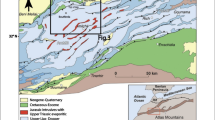Abstract
The study area covers 570 km2 comprising of 9 sub-watersheds (Dalavayihalli, Maddalenahalli, Talamaradahalli, Puluvalli tank, Nagalamadike, Gowdatimmanahalli, Naliganahalli, Devadabetta and Byadanur) range from 49 to 75 km2 forming part of Pennar river basin around Pavagada. The drainage network of 9 sub-watersheds was delineated using remote sensing data - Geocoded FCC of bands - 2 3 4 of IRS 1 C and 1 D (LISS III+PAN merged) on 1:50,000 scale and SOI topomaps were used as reference. The morphometric analysis of 9 sub-watersheds has been carried out using GIS softwares - Arclnfo and Are View. The drainage network shows that the terrain exhibits dendritic to sub-dendritic drainage pattern. Stream orders ranges from fourth to fifth order. Drainage density varies between 1.55 and 2.16 km/ km2 and has very coarse to coarse drainage texture. The relief ratio range from 0.006 to 0.021. The mean bifurcation ratio varies from 3.21 to 4.88 and falls under normal basin category. The elongation ratio shows that Devedabetta sub-watershed possesses circular shape while remaining sub-watersheds mark elongated pattern. Hence from the study it can be concluded that remote sensing techniques proved to be a competent tool in morphometric analysis.
Similar content being viewed by others
References
Agarwal, C.S. (1998). Study of Drainage Pattern Through Aerial Data in Naugarh Area of Varanasi District, U.P. Jour. Indian Soc. Remote Sensing,26(4): 169–175.
AIS & LUS (1990). Watershed Atlas of India, Department of Agriculture and Co-operation. All India Soil and Land Use Survey, IARI Campus, New Delhi.
Clarke, J.I. (1966). Morphometry from Maps. Essays in Geomorphology. Elsevier Publ. Co., New York, pp. 235–274.
GSI (1981). Geological and Mineralogical Map of Karnataka & Goa, Geological Survey of India.
Gottschalk, L.C. (1964). Reservoir Sedimentation. In: V. T. Chow (ed), Handbook of Applied Hydrology. McGraw Hill Book Company, New York, Section 7-I.
Horton, R.E. (1932). Drainage Basin Characteristics. Trans. Am. Geophys. Union,13: 350–361.
Horton, R.E. (1945). Erosional Development of Streams and their Drainage Basins; Hydrophysical Approach to Quantitative Morphology. Geol. Soc. Am. Bull.,56: 275–370.
Langbein, W.B. (1947). Topographic Characteristics of Drainage Basins. U.S. Geol. Surv. Water-Supply Paper,986(C): 157–159.
Miller, V.C. (1953). A Quantitative Geomorphic Study of Drainage Basin Characteristics in the Clinch Mountain area, Virginia and Tennessee, Proj. NR 389-402, Tech Rep 3, Columbia University, Department of Geology, ONR, New York.
Nag, S.K. (1998). Morphometric Analysis Using Remote Sensing Techniques in the Chaka Sub-Basin, Purulia District, West Bengal. J. Indian Soc. Remote Sensing,26 (1&2): 69–76.
Nag, S.K. and Chakraborty, S. (2003). Influence of Rock Types and Structures in the Development of Drainage Network in Hard Rock Area. J. Indian Soc. Remote Sensing,31 (1): 25–35.
NRSA (1995). Integrated Mission for Sustainable Development Technical Guidelines, National Remote Sensing Agency, Department of Space, Government of India, Hyderabad.
Reddy, P.R.R. and Rangaswamy, C.Y. (1989). Groundwater Resources of Pavagada Taluk, Tumkur District. Groundwater Studies No. 240. Department of Mines and Geology, Government of Karnataka, Bangalore.
Singh, S. and Singh, M.C. (1997). Morphometric Analysis of Kanhar River Basin. National Geographical. J. of India,43 (1): 31–43.
Schumm, S.A. (1956). Evolution of Drainage Systems and Slopes in Badlands at Perth Amboy, New Jersey. Geol. Soc. Am. Bull.,67: 597–646.
Smith, K.G. (1950). Standards for Grading Textures of Erosional Topography. Am. Jour. Sci.,248: 655–668.
Srivastava, V.K. (1997). Study of Drainage Pattern of Jharia Coalfield (Bihar), India, Through Remote Sensing Technology. J. Indian Soc. Remote Sensing,25 (1): 41–46.
Srivastava, V.K. and Mitra, D. (1995). Study of Drainage Pattern of Raniganj Coalfield (Burdwan District) as observed on Landsat-TM/IRS LISS II Imagery. J. Indian Soc. Remote Sensing, 23 (4): 225–235.
Strahler, A.N. (1957). Quantitative analysis of watershed geomorphology. Trans. Am. Geophys. Union,38: 913–920.
Strahler, A.N. (1964). Quantitative geomorphology of drainage basins and channel networks. In: V. T. Chow (ed), Handbook of Applied Hydrology. McGraw Hill Book Company, New York, section 4-II.
Author information
Authors and Affiliations
Corresponding author
About this article
Cite this article
Srinivasa Vittala, S., Govindaiah, S. & Honne Gowda, H. Morphometric analysis of sub-watersheds in the pavagada area of Tumkur district, South India using remote sensing and gis techniques. J Indian Soc Remote Sens 32, 351–362 (2004). https://doi.org/10.1007/BF03030860
Received:
Revised:
Issue Date:
DOI: https://doi.org/10.1007/BF03030860




